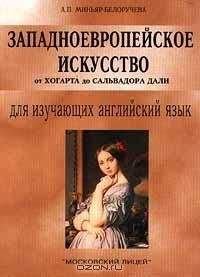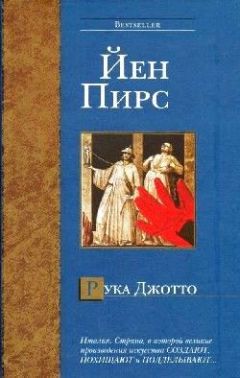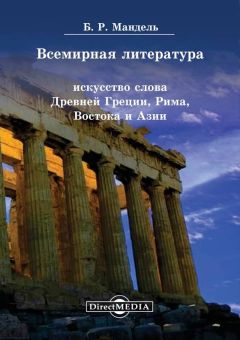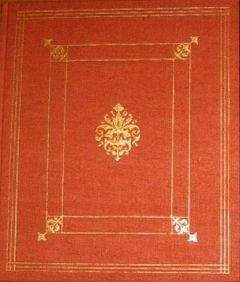А. Миньяр-Белоручева - Западноевропейское искусство от Джотто до Рембрандта
In this intricate iconographic structure the coming of Christ is foretold in the nine scenes from Genesis, according to the principle of correspondence between the Old and New Testaments that was illustrated repeatedly throughout Christian art. An added element is the oak tree of the Rovere family, to which Julius II and his uncle Sixtus iv belonged. The Rovere oak tree invaded the, scenes of Creation and alluded poetically to the Tree of Life, which stood near the Tree of Knowledge in the Garden of Eden and whose fruit in medieval theology was Christ.
The Fall of Man combines the Temptation and the Expulsion in a single scene, which in one motion leads the eye from the crime to punishment, linked by the Tree of Knowledge, represented as a fig tree. Never in history had nude figures been painted on such a colossal scale.
Michelangelo's vision of a new and grander humanity reaches its supreme embodiment in the Creation of Adam. Instead of standing on earth as in all earlier Creation scenes, the Lord floats through the heavens and is enveloped in the violet mantle he wears in all the scenes in which he appears. The violet colour is required for the vestments of the clergy during Advent and Lent, the penitential periods before the coming of Christ at Christmas and his resurrection at Easter. The Lord is borne by wingless angels. Michelangelo's Creator for the first time makes believable the concept of omnipotence. A dynamo of creative energy, God stretches forth his hand, about to touch with his finger the extended finger of Adam. This image of the creative finger derives from the famous medieval hymn «Come, Creator Spirit» sung at Pentecost, the festival of the Descent of the Holy Spirit. In this hymn the «finger of the paternal right hand» is invoked to bring speech to our lips, light to our senses, love to our hearts, and strength to our bodies. Adam reclines on the barren ground below, longing for life, and love about to be instilled by this finger. Adam means «Earth» and the finger is shown ready to be charged with the energy that will lift him from the dust and make him a «living soul». Adam's body is the most perfect structure ever created by Michelangelo. It embodies the beauty of Classical antiquity and the spirituality of Christianity.
The final scenes as one moves toward the altar were also the last in order of execution. TheLord Congregating the Waters was held to foreshadow the foundation of the Church. The Creationof Sun, Moon, and Plants shows the Lord twice, once creating sun and moon with a cruciform gesture of his mighty arms, then seen from the rear creating plants. Just above the altar the Lord separates the light from the darkness.
The seated prophets and sibyls show the majestic possibilities of the draped figure. Although Michelangelo's figures were clothed they looked nude. The Persian Sibyl was represented as immensely old, Jeremiah as grieving above the papal throne, Daniel aflame with prophecy as he writes in a small volume, the Libyan Sibyl looking down upon the altar, at the eternal Tree of Life. The final phase of the Sistine Ceiling is one of the supreme moments in the spiritual history of mankind. It was created during the years when Julius II, who commissioned and inspired the Sistine Ceiling, was fighting on the battlefield for the continued life of the Papal States against the armies of King Louis XII, and completed when the victory was won.
Make sure you know how to pronounce the following words:
Michelangelo Buonarroti; David; Moses; Ghirlandaio; Dante, Julius; Saint; Noah; Signorelli; Perugino; Goliath; Judith; Holofernes; sibyl
NotesPieta [ – Пьета («Оплакивание Христа»)
David- Давид
Moses – «Моисеи»
Dying Slave – «Умирающий раб»
Rebellious Slave – «Восставший раб»
Separation of Light from Darkness – «Отделение света от тьмы»
The Lord Congregating the Waters -» Отделение тверди от воды»
Creation of Sun, Moon, and Plants – «Сотворение светил и растений»
Drunkenness of Noah – «Осмеяние Ноя»
David and Goliath – «Давид и Голиаф»
Judith and Holofernes – «Юдифь и Голоферн»
Crucifixion of Human – «Человеческие страдания»
Brazen Serpent – «Змий-Искуситель»
Fall of Man – «Грехопадение»
Temptation – «Искушение»
Expulsion – «Изгнание из Рая»
Creation of Adam – «Сотворение Адама»
Persian Sibyl – «Персидская сивилла»
Jeremiah – пророк Иеремия
Daniel – Даниил
Libyan Sibyl – Ливийская сивилла
Tasks1. Read the text. Mark the following statements true or false.
1. Michelangelo's first masterpiece is the David.
2. The Moses was the first colossus of the High Renaissance.
3. The Redemption of man is the subject of the Sistine Ceiling.
4. Michelangelo's heavy nude figure was universally imitated by the painters throughout Europe.
5. Michelangelo imagined God over the altar.
6. Adam reclines on the fertile ground.
II. How well have you read? Can you answer the following questions?
1. Where did Michelangelo learn to paint? Where did Michelangelo study sculpture?
2. What is the Pieta famous for? What does the ageless Virgin symbolize?
3. Where is Michelangelo's heroic style seen?
4. What was Michelangelo commissioned in 1505? What remained from this project? How did Michelangelo represent Moses? How are the Dying Slave and the Rebellious Slave carved?
5. What was Michelangelo commissioned in 1508? How large was the ceiling?
6. What does the painting of the Sistine Ceiling represent?
7. What scenes are pictured in the lunettes around the windows and in the spandrels at the corners? Why does the oak tree invade the scenes of the creation?
8. What does the Fall of Man combine?
9. Where is the beauty of Classical antiquity and the spirituality of Christianity embodied?
10. What do the final scenes represent?
III. I. Give Russian equivalents of the following phrases:
the ageless exquisite Virgin; a formidable creation; lunettes; an activist prophet; to carve a statue; a buttress; to design a tomb; over-life statues in marble; successive reductions; a counterpart to; Advent; Lent; to set in action; the ceiling painting; to flank niches; a flattened barrel vault; an ambitious undertaking; a formidable creation; to allude poetically to; the vault compartments above the windows; generations of the ancestry; in the spandrels at the corners; to lift from the dust; a medieval hymn; to reach its supreme embodiment in; penitential periods; the resurrection at Easter; at Pentecost; to recline on the barren ground; a companion figure.
II. Give English equivalents of the following phrases:
ваять статую; соорудить гробницу; грандиозный замысел; неподвластная времени совершенная Мадонна; Воскрешение на Пасху; пророк-деятель; статуи выше человеческого роста; контрфорс; Великий пост; Рождественский пост; раскинуться на голой земле; люнеты; в пазухах свода; внушительное произведение; фланкировать ниши; пятидесятница; плоскость свода; поэтически ссылаться на; средневековый гимн; парная фигура; поколения предков; привести в движение; последовательные сокращения; достичь наивысшего воплощения в; поднять из праха; соратник к. -л.
III. Make up sentences of your own with the given phrases.
IV. Arrange the following in the pairs of synonyms:
a) recline; barren; penitential; undertaking; to enhance;
b) sorrowful; endeavour; lean back; to intensify; infertile.
IV. Insert the missing prepositions. Retell the text.
… 1519 Michelangelo began working… the Medici… a funerary chapel… the entombment… Lorenzo the Magnificent, his murdered brother and two recently deceased dukes. Michelangelo's architecture supports the tombs… the two dukes… simple rectangular niches sit the two dukes, dressed… Roman armour… their roles as captains… the Roman Catholic Church. The sarcophagi have been split… the centre… either side recline figures… the times… day, Night and Day, Dawn and Twilight. These statues were not made… their present positions. The composition should be completed… the reclining river gods. Night and Day are the timeless symbols… the princely power that has conquered the powers… time (the times… day) and… space (the four rivers). When Michelangelo was engaged… this work glorifying the Medici power, the Sack… Rome destroyed temporarily the power… his Medici patron. The republic was revived… the third and the last time, and Michelangelo was placed… charge… its defences.
V. Insert the articles wherever necessary. Retell the text.
… High Renaissance in… Rome and Florence was brief. It lasted hardly more than… twenty five years from its beginning in… Leonardo's Last Supper to… death of… Raphael in…1520… new style succeeded it. It existed for… while… side by… side with… latest phases of… High Renaissance art… new style assumed… name of Mannerism… name Mannerism was proposed by… art historians in… twentieth century. Like… terms… Romanesque and… Gothic, Mannerism is here to stay… Mannerism indicates… style founded upon repetition of… acquired manual techniques. In… latest phases of… sixteenth century art in… central Italy there was much repetition of… type and… devices invented earlier, especially those of… Michelangelo. There was nothing mechanical what went on in… Florence,… Seine,… Parma and… many other Italian cities just before and just after…1520… moment was recognized as… spiritual crisis.
VI. Here are descriptions of some of Michelangelo's works of art. Match them up to the given titles.
I. Sculpture:
1. The figure is turning languidly as if in sleep.
2. This is one of the artist's most formidable creations.
3. The exquisite Virgin presents the timeless reality of Christ's sacrifice.
4. The heroic style is seen in this statue.
5. The new figure type earlier created by Michelangelo is set here in action.
a. David
b. Pieta
c. Rebellious Slave
d. Moses
e. Dying Slave
II. Ceiling painting:
1. God stretches forth his hand, about to touch with his finger the extended finger of Adam.
2. It foreshadows the foundation of the Church.
3. In a single scene, one motion of the eye leads from the crime to punishment, linked by the Tree of Knowledge.
4. The scene shows the Lord twice, once creating sun and moon with a cruciform gesture of his mighty arms, then seen from the rear creating plants.
5. She looks down upon the altar, at the eternal Tree of Life.
6. He writes in a small volume.
7. The figure is represented as im- mensely old.
8. The figure is grieving above the papal throne.
a. Fall of Man
b. Creation of Sun, Moon, and Plants
c. Creation of Adam
d. Lord Congregating the Waters
g. Jeremiah
h. Daniel
e. Libyan Sibyl
f. Persian Sibyl
VII. Translate the text into English
Центральную часть потолка Микеланджело посвятил сценам священной истории, начиная от сотворения мира. Под живописным карнизом Микеланджело написал пророков и сивилл, в люнетах изобразил эпизоды из Библии и предков Христа как простых людей. В девяти центральных композициях развертываются события первых дней творения: отделение света от тьмы, отделения тверди от воды, сотворение светил и растений, сотворение Адама и Евы, грехопадение и изгнание из Рая, всемирный потоп, опьянение Ноя. Микеланджело сотворил чудо. Целой жизни не одного, а многих людей не хватило бы, чтобы завершить это великое творение. Микеланджело работал один. Он создал гимн человеку. Бог – это прежде всего творец, не знающий преград на пути созидания. Адам идеально прекрасен в сцене «Сотворение Адама». Величие, мощь, благородство выражены в образах пророков и сивилл.
Несмотря на большое количестве фигур, роспись Сикстинского плафона логически ясна и легко обозрима. Она не разрушает плоскости свода, а выявляет тектоническую структуру.
VIII. Summarize the text.
IX. Topics for discussion.
1. Michelangelo's sculpture.
2. Michelangelo's ceiling painting.
3. Michelangelo's artistic heritage.
Unit VII Raphael (1483-1520)
Raffaello Sanzo, known as Raphael, was the third giant of the High Renaissance. In his art the High Renaissance ideal of harmony comes to its most complete expression.
Raphael was born in Urbino. First taught by his father, Giovanni Santi, a mediocre painter, Raphael worked for some time in the studio of Perugino.
In 1504 Raphael painted The Marriage of the Virgin for a church of Citta di Castello. The central group is unified around the motive of Joseph putting the ring on Mary's finger. The architecture of the distant Temple grows out of a wide piazza. The Dome of the Temple is identified with that of Heaven. The perspective of the squares in the piazza moves through the open doors of the building to the point of infinity.




